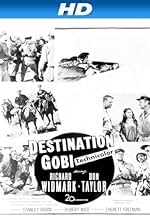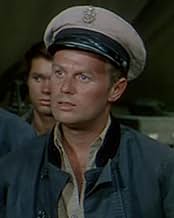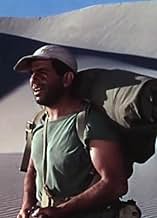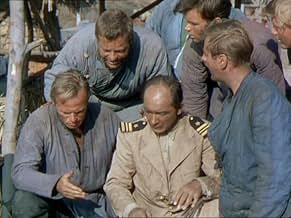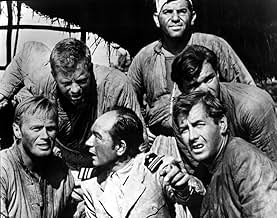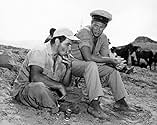En 1944, especialistas de la marina estadounidense dirigen una estación meteorológica en el desierto de Gobi, donde son acosados por aviones de guerra japoneses, pero reciben la ayuda de los... Leer todoEn 1944, especialistas de la marina estadounidense dirigen una estación meteorológica en el desierto de Gobi, donde son acosados por aviones de guerra japoneses, pero reciben la ayuda de los nómadas mongoles locales.En 1944, especialistas de la marina estadounidense dirigen una estación meteorológica en el desierto de Gobi, donde son acosados por aviones de guerra japoneses, pero reciben la ayuda de los nómadas mongoles locales.
- Dirección
- Guionistas
- Elenco
- Walter Landers
- (as Casey Adams)
- Yin Tang
- (sin créditos)
- Capt. Gates
- (sin créditos)
- Admiral
- (sin créditos)
- Quartermaster General
- (sin créditos)
- Pilot
- (sin créditos)
- Frank Swenson
- (sin créditos)
- Lieutenant
- (sin créditos)
Opiniones destacadas
The tale of "a bunch of weathermen chasing balloons" across Inner Mongolia, the most arduous part of shooting Robert Wise's first colour film was probably lugging the enormous Technicolor camera about; which paradoxically makes it incongruously pretty to contemplate.
Being relatively low-budget Destination Gobi is rather short on action, instead relying upon suspense sequences and musings on military life for its entertainment value. Sadly the screenplay isn't quite up to the task. There is a sprinkling of quasi-philosophical dialogue, most of which is feeble and unconvincing (the only line I liked was the one about Inner Mongolia being "hotter, dryer and inner"). The characters are the usual B-movie one-dimensionals, and many scenes are so lacking in credibility the tension can't work because there is no real sense of danger.
This is where Robert Wise comes in. It's often interesting, albeit dissatisfying, to see a really top-notch director slumming it in a B-unit to see what they can make out of the weakest of elements. This is especially true of Wise, who had no ego and always aimed to make the best out of whatever the studios threw at him. This is his first colour picture and, as far as I know his earliest to really make use of wide-open spaces. Most of Wise's pictures up until now had been gritty thrillers, and even his 1948 horse opera Blood on the Moon is literally a dark Western. It's been remarked by others that the landscape in Destination Gobi is filmed to show off its beauty, but also watch Wise's timing. It would be normal convention to cut to a landscape shot after the opening scene at SACO HQ, but in fact Wise takes care not to properly show us the desert and emphasises the smallness and darkness of the tent. Only after the Mongols have been introduced do we get these breathtaking outdoor shots. The contrast is striking and it makes us associate the Mongols with the beauty of the location, even if only subconsciously.
I am sure Wise knew he had been given a bum script, and he takes advantage of the quiet moments. Wise's direction was generally at its best when there was no dialogue anyway (check out Lawrence Tierney in Born to Kill) and he particularly seemed to like drawing out these moments and giving the actors space to emote. Consequently there is tenderness uncharacteristic of such a picture when the soldiers mourn a fallen comrade, opening the scene with a respectful long shot of the gravesite. Again the natural beauty of the landscape is used, this time as a bittersweet counterpoint.
The cast is headed by Richard Widmark, who like Wise was good at what he did yet spent much of his career in B-flicks. And, as with Wise, we can look at this positively and say that he at least leant some quality to pictures that have very little else going for them. He can't quite make the appalling dialogue sound plausible, but at least he emotes well and has strong presence. The Mongol characters may not be granted any dignity by the screenplay, but at least the reliable Murvyn Vye turns in a dignified performance as Chief Kengtu, adding a layer of personality to the character that is not there in the script.
These little oases of quality do not prevent Destination Gobi from mostly being a desert of mediocrity. Studying Robert Wise's work, this is like a little exercise in thoughtful direction, but nothing more because there isn't enough depth to the story or characters to make it pay off. And who would expect more from a ninety-minute no-brainer? However, at least the efforts of Wise (as well as renowned art directors Lyle Wheeler and Lewis Creber, and cinematographer Charles Clarke well-deserved honourable mentions) have made it nice to look at. It's occasionally even entertaining as well.
It's not an assignment that a guy who was a CPO on the USS Enterprise in 1944 is looking for. But that's what he's drawn. Widmark is to assist Captain Russell Collins in setting up one of a series of weather station in Inner Mongolia, that is that part of Mongolia located inside the Great Wall of China.
Collins is a meteorologist with a Navy commission, so Widmark is really the guy in charge. Setting up the advance outpost, the dozen or so sailors have to establish good relations with the local Mongol tribesmen who pretty much live as they did under Genghis Khan. The gifts that put it over are a requisition for some old army saddles from the late U.S. Cavalry.
Later on the Japanese bomb the station and Collins and others are killed. It's up to Widmark to get his men out of the Gobi Desert and avoid falling into the hands of the Japanese. The Mongols and their saddles prove to be of invaluable assistance.
I think Destination Gobi got a bit off track after the Japanese attack. The first part of the film was quite good, especially depicting the Mongol culture. But after the attack the escapades of the men trying to get to U.S. lines which in this case means to Eastern China and across the water to Okinawa was a bit much. The Japanese were shown to be as dumb as the Axis powers were shown during World War II and the height of the propaganda films made back then. Richard Loo who played so many nasty Japanese back in the day was the Japanese commander and he must have had a recurring case of deja vu.
Still Widmark does a fine job as does Murvyn Vye who is the head Mongol. They are ably supported by such stalwart character players as Don Taylor, Martin Milner, Casey Adams, Darryl Hickman, and Earl Holliman.
Destination Gobi could have been a much better film.
This a sympathetic movie in which interest and entertainment never fall . The screenplay contains implausible adventures , goodhumoured scenes , tongue-in-cheek excitement , agreeable situations with the laughs in the right places .Widmark plays an US Navy officer assigned to take charge a bunch of meteorologistics at a remote weather station , when a Japanese attack leaving to him and his company alone in the wilderness to fend for themselves , Richard gives the film enough security and authority . And he is backed by a magnificent cast that includes Don Taylor , Russell Collins , Murvyn Vye , Casey Adams , Willis Bouchey , Darryl Hickman , Rodolfo Acosta , Richard Loo and Earl Holliman , Martin Milner film debut . And Paiute Indians living in reservation where was shot the movie played Mongol extras .
Musical score from Alfred Newman and Sol Kaplan is highly commendable. Colorful cinematography in Technicolor by Charles Clarke , being Wise's first color movie . Being filmed on location in Nixon and Fallon and other Indians reservation . Produced and released by 2oth century Fox and well directed by Robert Wise who never lets the action sag .Wise was a good director who made films in all kinds of genres , nowadays , some of them considered classic movies , such as : Musical : West side story , The sound of music ; SciFi: The day the Earth stood , Andromeda strain , Star Trek the motion picture ; Terror : The haunting , The body snatchers, , Audrey Rose , Curse of cat people ; Wartime : Run silent Run deep , The Desert Rats ; Historical : Helen of Troy ; Western : Tribute to a bad man ; Drama : I want to live , The Set-up , among others
¿Sabías que…?
- TriviaNixon and Fallon, NV were both used as location sites, and Paiute Indians residing on a reservation in Nixon played Mongol extras.
- ErroresMcHale claims that "Gobi Desert" means "wall of spears." Actually, "Gobi" is the Mongolian word for "desert."
- Citas
[Walter flirts successfully with a Mongolian woman]
Jenkins: Well, looks like you made a hit, Walter my boy. Tell me, how do you do it?
Walter Landers: My training as a meterorologist. I can take one look at a girl and tell weather.
- Créditos curiososOpening credits prologue: In the Navy records in Washington, there is an obscure entry reading "Saddles for Gobi."
This film is based on the story behind that entry--one of the strangest stories of World War II.
- ConexionesEdited into All This and World War II (1976)
Selecciones populares
- How long is Destination Gobi?Con tecnología de Alexa
Detalles
Taquilla
- Presupuesto
- USD 1,340,000 (estimado)
- Tiempo de ejecución
- 1h 30min(90 min)
- Color
- Relación de aspecto
- 1.37 : 1


